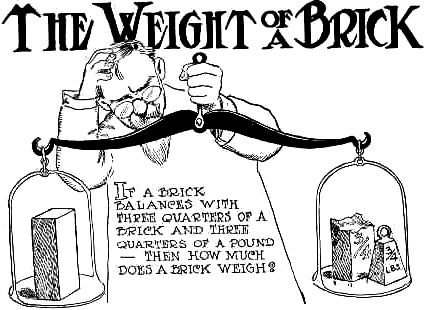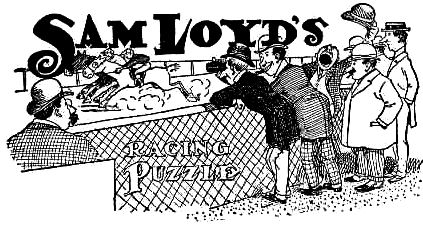



Here is a little puzzle designed to illustrate the principle of cancellation as applied in algebra to discover an unknown weight from a fractional part of itself. As these kindergarten illustrations are given to instruct beginners in the rudimentary principles of algebra, and not for the purpose of puzzling them, we present the explanation with the picture before them.
Algebra teaches us that the balance is not affected by removing similar quantities from both sides of an equation, so, in this puzzling little proposition we remove three-quarters of the whole brick and cancel off the three-quarter bat. This leaves the weight balancing with one-quarter of a brick; therefore if one quarter of a brick weighs three-quarters of a pound, a whole brick weighs three pounds. It suggests a possible solution to Uncle Jake’s problem of the goose which weighed seven pounds and five-sevenths of its own weight. But then the goose always said there was no answer to the problem.
We almost lose veneration for the big fish story which for several centuries has been the terror of every graduating scholar. The head of the fish was nine feet long, the body as long as the head and tail together, and the tail as long as the head and half of the body. The head being a known quantity we find the length of the body to be 9 plus half of the tail. The tail therefore equals 9 (the head) and half of 9 (4 1/2) which makes 13 1/2 added to half of itself. Here is where the resemblance to the brick problem comes in. The tail is 13 1/2 long and half of itself. If one half equals 13 1/2, both halves equals 27 feet. Thus we have the length of the tail as 27 feet, and the body 36 feet, so 9 plus 36 plus 27 shows that Baron Munchausen must have landed a 72 foot fish, and he caught it with a hook.
2. A Rebus
My first is a preposition.
My second implies more than one.
My third is a pronoun.
My fourth some people never pay.
My whole is not consistent.
Cipher Answer.—9, 14, 3, 15, 8, 5, 18, 5, 14, 20.
INCOHERENT
3. A Rebus
My first in pageant grand oft forms a part,
My second is the darling of your heart;
My whole within your parlor may be seen,
Where, safe, to say, my second oft has been.
Cipher Answer.— 3, 1, 18, 16, 5, 20.
CARPET
4. A Charade
My first presents an honored female name,
But lovingly abbreviated;
My next a man's, and treated just the same.
Now, if this couple were only mated,
And to the altar duly led,
To be my whole which might be said.
Mated
5. A Rebus
Though of my first the quack may boast,
My next he cannot cure;
Who do my whole along the coast
Should punishment endure.
Cipher Answer.—16, 9, 12, 12, 1, 7, 5,
PILLAGE
6. A Rebus
My first, dear ladies, you will find,
Is of my second made;
My whole with pleasure is designed
Upon my first to wait.
Cipher Answer.— 2, 18, 9, 4, 5, 19, 13, 1, 9, 4.
BRIDESMAID
7.

It was told that two lads, each with the same amount of cash, played the races upon Lord Rosslyn’s system of placing as many dollars upon the poorest horse as they offer odds of so many dollars against a single dollar [e.g. if the odds are 10 to 1, a $10 bet is placed - jws]. Jim backed “Kohlnoor” to win straight, while Jack bet on him for second place, so they put up different amounts at different odds, although the amount of their bets together was equal to half of their combined capital. They both won, but when they cashed their winnings and counted their capital, Jim had twice as much money as Jack. Now, who can guess the amounts won?
There would be many answers to the problem of playing the races were it not for the fact of fractional parts of a dollar being contrary to the rules of the turfites, so the only amounts which satisfy the conditions of the problem are that each lad had $40. Jim bet $15 at 15 to 1 straight, and won $225, which with his original $25 equals $250. Jack bet $10 at 10 to 1, for second place, and won $100, which with his $25. equals $125; so he has just half as much as Jim. Algebraically expressed the problem is simply 2 (a2 + a) = b2 + b.
[Page 50]